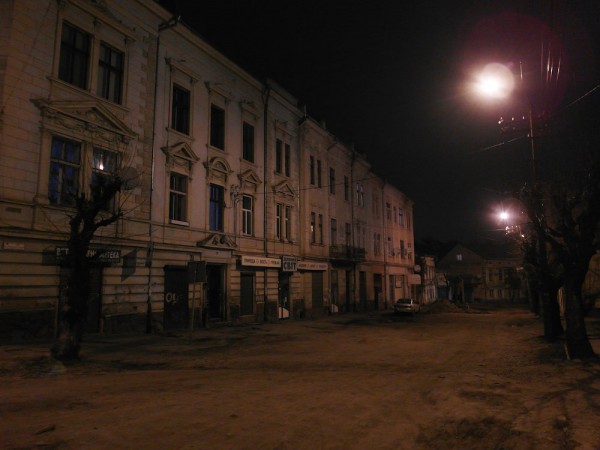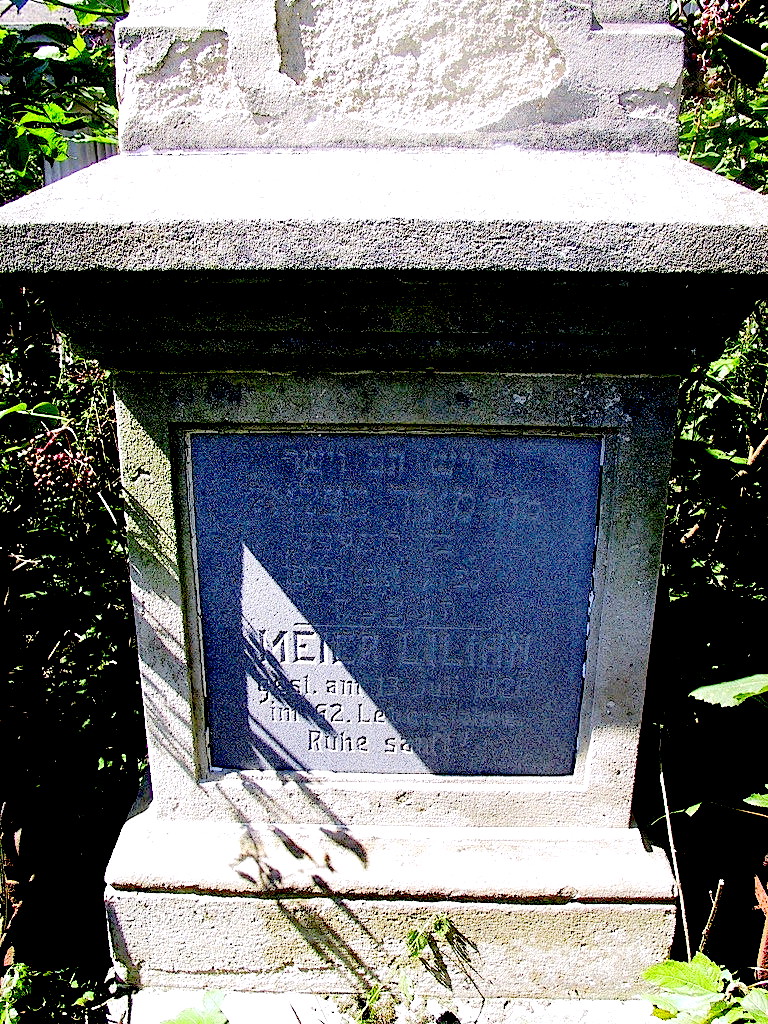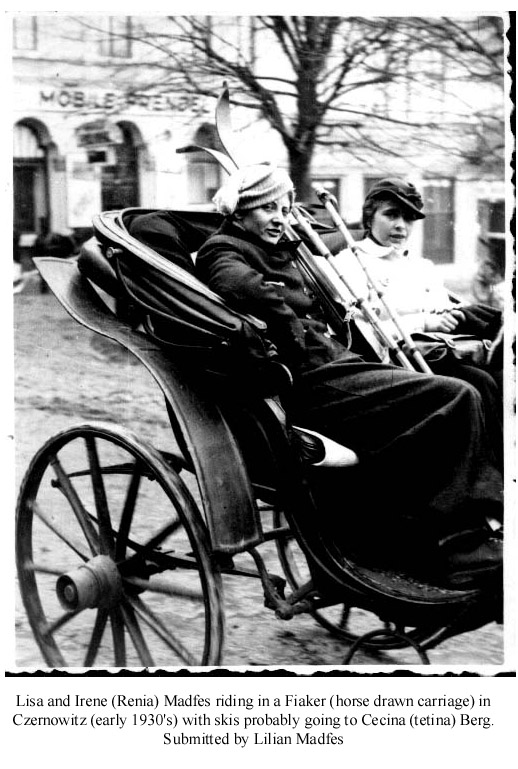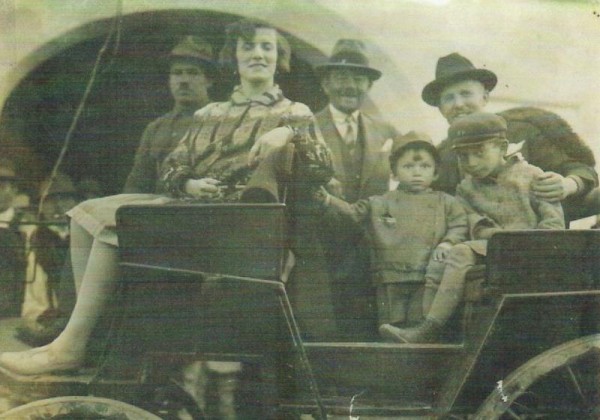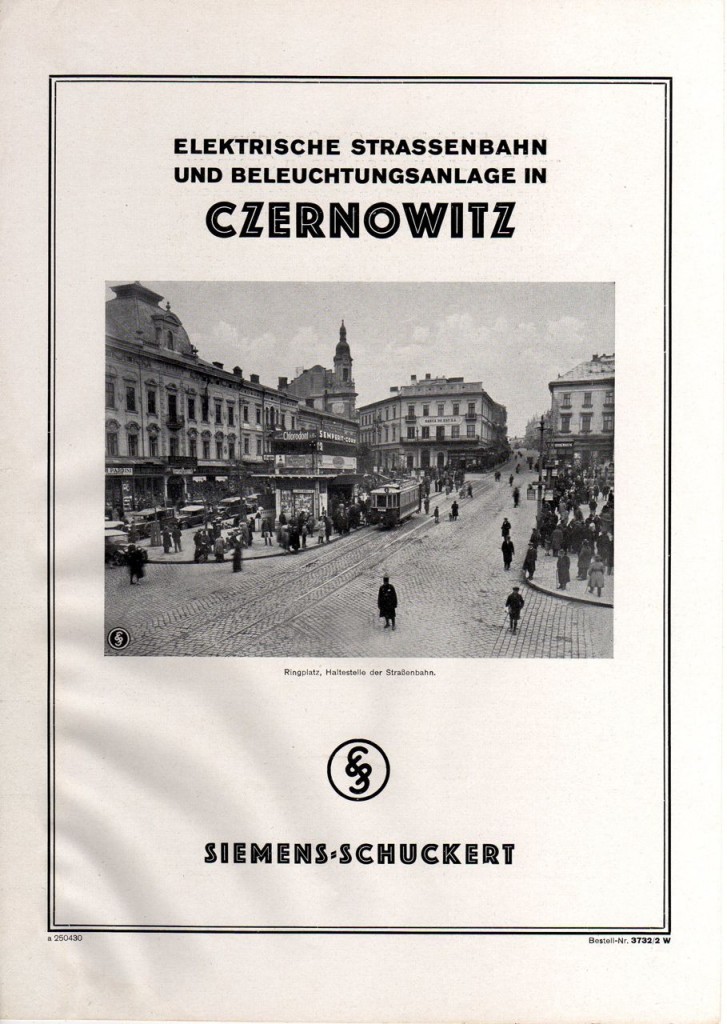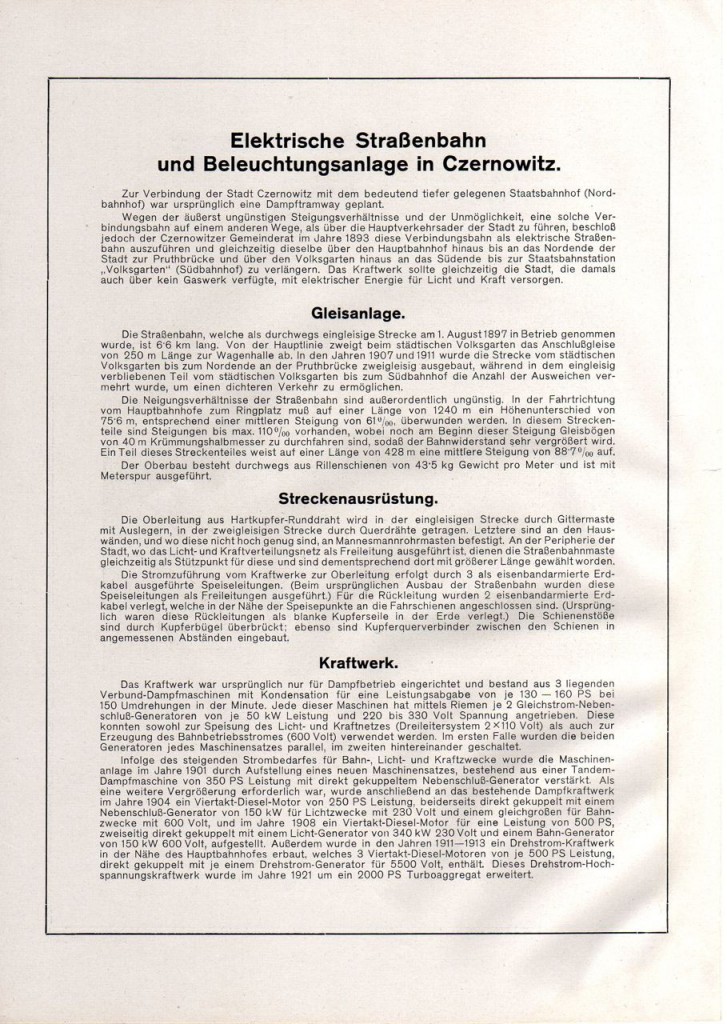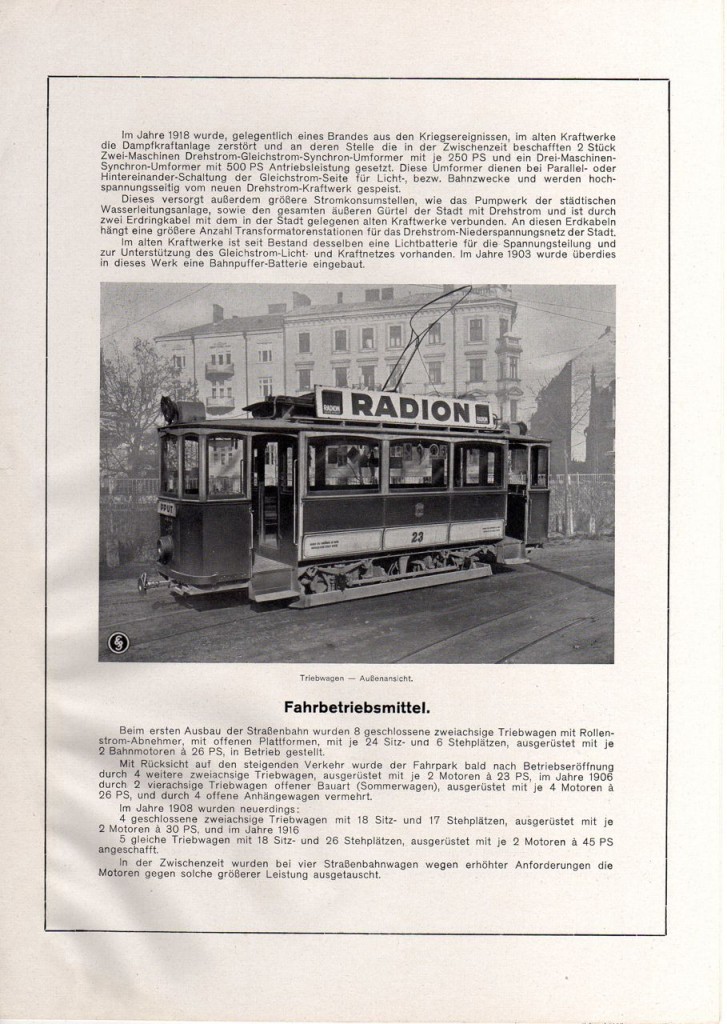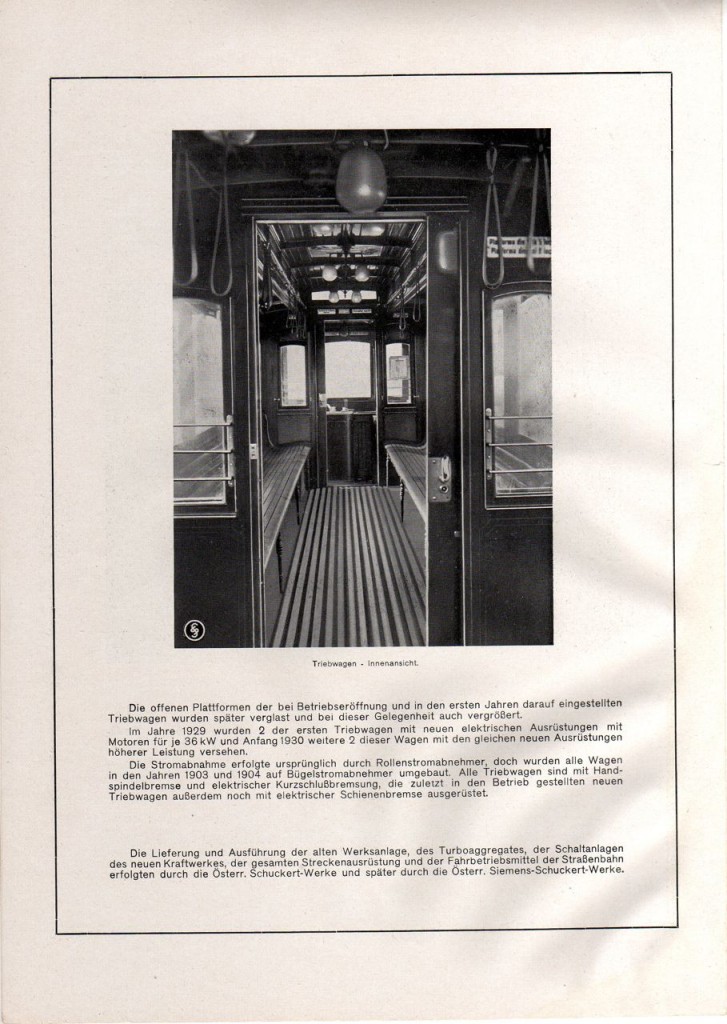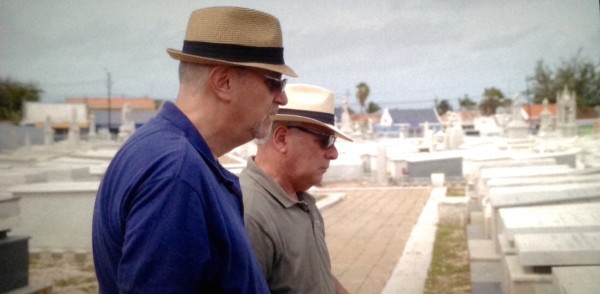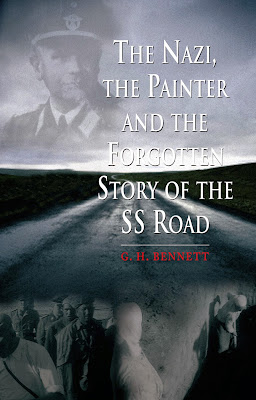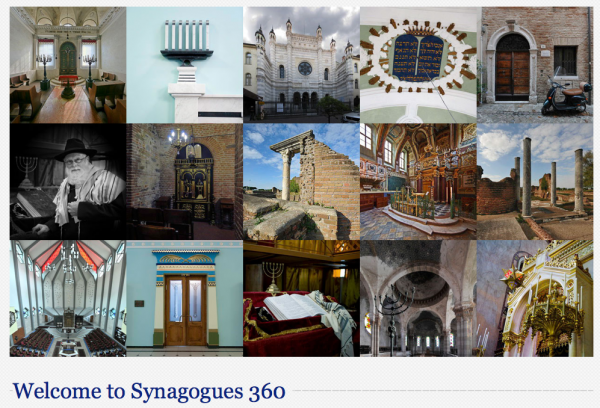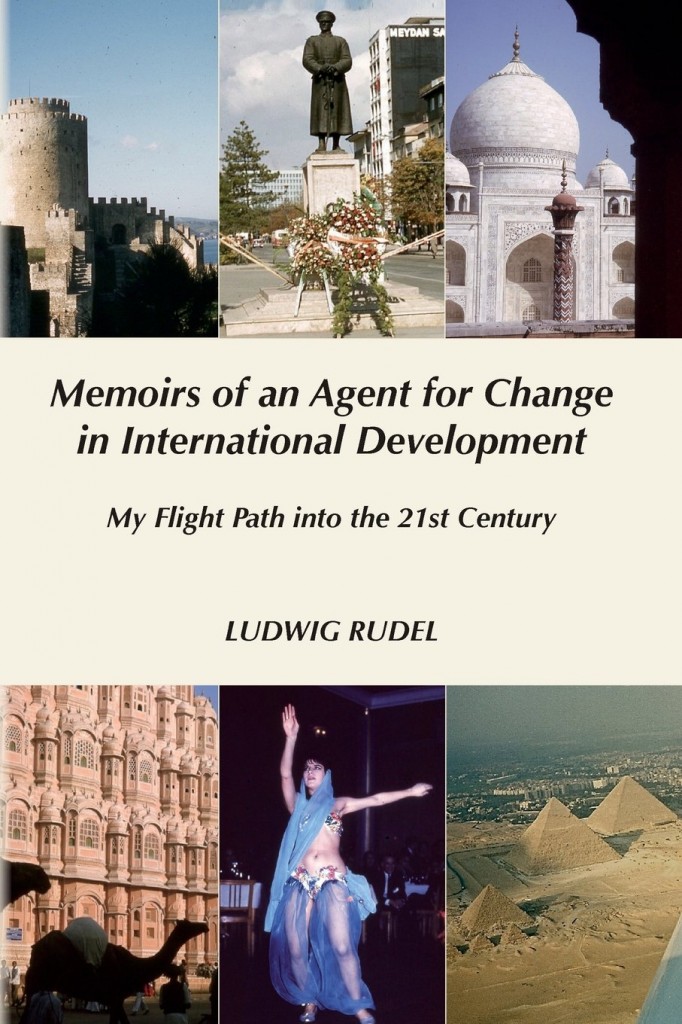Author Archives: Edgar Hauster
Ulrich Gansert’s Bukovina Winter Journey December 2014
The Lilien/Lilian Family
I am from Johannesburg, South Africa. I am investigating the Lilien/Lilian family who lived in Czernowitz. I have managed to find out the following:
My great grandfathers name was Wilhelm lilian ( must have become William when he arrived in Australia before WW2) – he had 2 brothers – Joseph and Ossies (all born in Czernowitz), their fathers name was Meier. Wilhelm was born in Czernowitz. I have found a picture of Meier Lilian tombstone in Czernowitz cemetary – but it is an unclear photo.
Meier died on 12 July 1926 and is buried in Czernowitz. Wilhelm was born on 17 January 1891 or 1892 and died in Sydney, Australia 13 November 1964.
Does anyone have any further information about the lilian family? or know who would have info? I am also investigating if the lilian family in Czernowitz is related to the famous artist Ephraim Moshe lilien.
Please let me know
Thanks in advance
Danny
Coach Ride in Czernowitz

Dow Friedman: “Photo in the Horetchawald – Isiu Engler, husband of Mania (Maria) (neé Kuperman) eldest sister, my mother, Genia , Dow and my father, Itzik.”
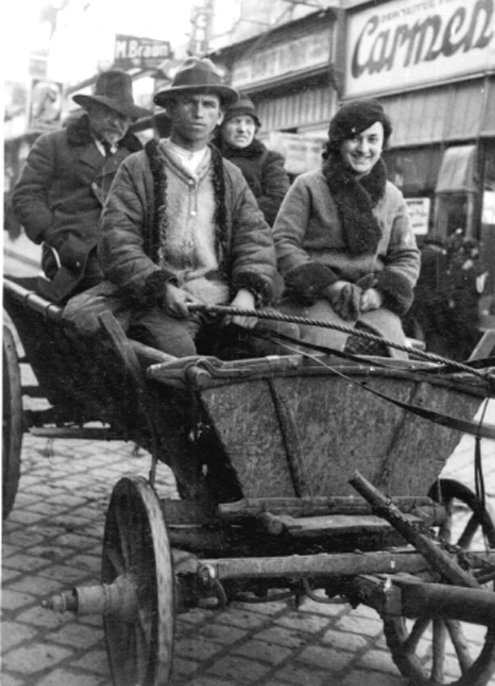
Mimi Taylor: “‘Shopping’ from either 1935 or 1936. In the front is Frieda Jagendorf, in the back are my maternal grandparents Saul-Leib and Scheindel Steinmetz.”
Tramway and Electrical Lighting Equipment in Czernowitz
35 Jahre
Elektrizität in Cernauti
(Aus einem Gespräch mit dem Direktor Ing. Hildebrand)
Czernowitz feiert heute das 35-jährige Jubiläum der Einführung des elektrischen Lichtes und des Tramway-Verkehres in dieser Stadt.
Während das Gas für Beleuchtung und Heizzwecke in die Bukowina bis heute keinen Eingang gefunden hat, wurde elektrisches Licht schon in den neunziger Jahren in Czernowitz, allerdings nur vorübergehend, verwendet. Damals hat man bei einem Ball der akademischen Verbindung „Lesehalle“ im Musikvereinssaale für einen Abend eine Maschine aufgestellt, die durch ein Lokomobil angetrieben wurde und zum ersten Male elektrisches Licht aufleuchten ließ, was ungeheueres Aufsehen erregte. Kurze Zeit darauf installierte der damalige Pächter des „Hotel Central“, Silber, im Keller des Gebäudes ein Lokomobil mit einer elektrischen Lichtmaschine und beleuchtete damit die Hotelanlagen. Damit war der erste Schritt zur Benützung der Elektrizität für Beleuchtungszwecke in der Bukowina getan und das Interesse der Bevölkerung für diese Beleuchtungsart geweckt.
Im Jahre 1895 hat die Stadtgemeinde Czernowitz sich entschlossen, ein Werk für Beleuchtungszwecke zu errichten, wobei längere Zeit darüber verhandelt wurde, ob Gas oder Elektrizität zu diesem Zwecke einzuführen wären. Im Bestreben, mit dem Fortschritt zu gehen, entschloß man sich schließlich für die Errichtung eines Elektrizitätswerkes. Der Betrieb für Licht- und Kraftzwecke wurde im Jahre 1896, der Betrieb der Straßenbahn am 1. August 1897 aufgenommen.
Durch die Schaffung des Elektrizitätswerkes und der Straßenbahn tat die Stadt Czernowitz einen großen Schritt nach vorwärts und wurde dem Westen nicht nur näher gebracht, sondern konnte diesem zum Teile als Vorbild gelten, da Mitte der neunziger Jahre nicht viele Städte des Westens Elektrizitätswerke und nur wenige Städte Europas elektrische Straßenbahnen besaßen. Allerdings hatten die Weststädte damals bereits Gaswerke und empfanden den Mangel an elektrischem Licht nicht im gleichen Umfange wie bisher Czernowitz. Den Vorrang hatte damals Czernowitz sogar der damaligen Reichshauptstadt Wien gegenüber, da selbst diese sich für die Straßenbeleuchtung des Gasflügelbrenners (das Auerlicht war noch nicht erfunden) und der Pferdetramway, sowie des Pferdeomnibusses bediente. Aehnlich stand es in jenen Zeiten auch in Berlin.
In den Anfängen des Betriebes des Elektrizitätswerkes und der Straßenbahn hatte dieses Unternehmen mit materiellen Schwierigkeiten zu kämpfen, da die Bevölkerung in der ersten Zeit den Wert und die Wohltaten des elektrischen Lichtes noch nicht erfassen konnte, ja in einigen Fällen sogar diesem „Teufelswerk“ feindselig und ablehnend gegenüberstand.
Die ersten Gebäude, welche in Czernowitz das elektrische Licht einführten, waren das „Hotel Central“, Hotel „Schwarzer Adler“ und der Stadtmagistrat. Für die Straßenbeleuchtung wurde das elektrische Licht nur im Stadtzentrum eingeführt, während die Peripherie der Stadt sich noch immer mit den tieftraurig brennenden Lampen auf rotweißgestrichenen Holzpfählen begnügen mußte. Doch auch für die elektrische Straßenbeleuchtung wurde nahezu bis in die letzten Jahre der Vorkriegszeit nur in den Hauptstraßen der innersten Stadt Bogenlampen benützt, während die übrigen Straßen sich mit Glühlampen begnügen mußten. Erst allmählich erkannte die Bevölkerung die Vorteile des elektrischen Lichtes, sodaß schon im Jahre 1901 die Elektrizitätswerksanlage um einen neuen Maschinensatz erweitert werden mußte.
Die elektrische Straßenbahn, von der bei Betriebserrichtung und in der ersten Betriebszeit sich insbesondere die untersten Schichten der Bevölkerung ziemlich fern hielten, (weil sie nicht erfassen konnten, wie es möglich war, daß die großmächtigen Wagen ohne Pferdevorspann durch die Straßen rollen und mancher geneigt war, zu glauben, daß der böse Geist mit im Spiele wäre, da die Wagendeichsel sich auf dem Dache befand und die Räder an den Schienen infolge der Besandung der neuerbauten Strecke langmächtige Feuergarben zogen), litt anfangs an Defizit. Schon nach kurzer Zeit jedoch kam die Bevölkerung zur Ueberzeugung, daß behufs Zeitersparnis und der Möglichkeit, um billiges Geld und besonders den Bahnhofsberg zum Ringplatz leicht hinaufzukommen, die Benützung der Straßenbahn von Vorteil sei. Dadurch erhöhte sich die Frequenz der Straßenbahn, sodaß schon im Jahre 1899 der Wagenpark um vier neue Straßenbahnwagen auf 12 erhöht wurde.
Der Fortschritt der Technik brachte um das Jahr 1900 den Dieselmotor, so daß auch unser hiesiges Elektrizitätswerk im Jahre 1903 einen Dieselmotor zwecks weiterer Vermehrung der Leistung zur Aufstellung brachte. Hiebei ist es besonders bemerkenswert, daß wieder Czernowitz dadurch bahnbrechend wirkte, daß der erste 250 P. S. Dieselmotor hier zur Aufstellung gelangte.
Allmählich wurde der Aktionsradius für die Versorgung mit Elektrizität erweitert, das Interesse der Bevölkerung erhöht und dadurch war die Notwendigkeit weiterer Ausbauten der Elektrizitätswerksanlagen erforderlich geworden. Da aber die Werkanlagen in der Althgasse nahe dem Abhang gegen den Klocucicabach errichtet wurde, weil die Universität bei Errichtung des Werkes Einspruch gegen den Bau desselben hinter den Universitätsinstituten erhoben hatte, war die Erweiterung dieser Werkanlagen im Rutschterrain nicht mehr möglich, sodaß man schließlich im Jahre 1911 an die Errichtung eines neuen modernen Hochspannungsdrehstrom-Werkes in der Pruthgasse schreiten mußte, welches am 27. April 1912 mit zwei Dieselaggregaten je 500 P. S. in Betrieb genommen wurde. Schon im Jahre 1913 wurde auch dieses neue Werk um ein neues Aggregat von 500 P. S. erweitert.
Auch der Wagenpark der Straßenbahn wurde in der Zwischenzeit vermehrt und die ursprünglich eingeleisig gebaute Bahnstraße durch eine Doppelgeleiseanlage zwischen Volksgarten und Pruthbrücke erweitert.
Im Jahre 1921 schritt die Gemeinde, welche schon im Jahre 1909 die im Besitze der Fa. Schuckert & Co. befindlich gewesenen Aktien ganz übernommen hatte und Alleinbesitzerin des ganzen Gesellschaftsvermögens war, zur Auflösung der Aktiengesellschaft und Kommunalisierung der Werkanlagen. In diesem Jahre wurde auch das neue Werk um einen Doppelturbinenaggregat von 2000 P. S. von der Siemens Schuckert und der ersten Brünner Maschinenfabrik A. G., im Jahre 1931 um einen weiteren Turbinenmotor von 5000 P. S. von der Fa. Brown-Bowery erweitert. Auch der Wagenpark wurde inzwischen weiter vermehrt und beträgt 24 Motorwagen und zwei Aufladewagen. Durch die Aufstellung dieses 5000 P. S. Aggregates wurde ermöglicht, daß auch die Vorstädte in den Beleuchtungsrayon einbezogen wurden. M. L. (Der Tag, Czernowitz, 12.06.1932)
“A Shtetl in the Caribbean”, a Roadmovie Documentary…
Trailer A Shtetl in the Caribbean from Memphis Film & Television on Vimeo.
A SHTETL IN THE CARIBBEAN tells the compelling story of two childhood friends who grew up on Curaçao, in search for their family history in Eastern Europe.
Mark and Tsale, children of Eastern European Jews that fled to Curaçao, travel back to the home countries of their ancestors. In a documentary road-movie across Curaçao, the United States, Belarus, Ukraine and Israel, we witness their discoveries, courage and despair while they are reminded of the sacrifices their parents had to make to provide their family with a better future.
This unknown story is revealed in a journey from the desolate wastelands of Eastern Europe to the exotic Caribbean, a contrast metaphoric for the history of Mark and Tsale’s ancestors.
A SHTETL IN THE CARIBBEAN originated from a strong emotion: we are all part of the same family, no matter how different we are. The film is also an homage to Curaçao, a small island with a big heart, and a place that has been a safe haven for strangers. Only in such a place a human being can truly build a home.
BIOGRAPHY MARK WIZNITZER
Named after his two deceased grandfathers per Jewish tradition, Mark Leon Wiznitzer was born in the US and brought to Curacao as a baby. There he was called “ Buchi, ” a popular island nickname that legend dates back to the strongest African slave broken by the loss of his beloved wife, and is still often given to a native first son. In Willemstad, Mark attended the Dutch-language Hendrikschool before he moved to New York City at the age of eleven with his mother. But he returned to spend all his school vacations on Curacao, where he worked with his father in La Confianza, the family-owned department store. After studying political science at the State University of NY in Buffalo, Mark went on to complete a Masters in Foreign Service at Georgetown University. He worked in Curacao for Wiznitzer Brothers, the family’s retail and wholesale business, for a year before he was selected to join the US Department of State as a career diplomat in 1976, at which time he left Curacao for good. During his various assignments in Washington DC, Latin America and Europe, he earned awards for his performance in political and politico-military affairs, and strategic trade. After retiring in 1999, Mark completed an Executive MBA in Vienna. He was a volunteer for Barak Obama’s campaigns for the Democratic nomination and election as President. As a result of his first visit in 2010 to Vashkivtsi, Ukraine, the birthplace of the four Wiznitzer brothers, he organized his family’s restoration of the neglected Jewish cemetery there. He currently lives with his wife, Paula Goddard, in Virginia, where he recently became a volunteer advocate for senior residents of Arlington County.
BIOGRAPHY TSALE KIRZNER
Tsale Kirzner was born on Curaçao as the oldest son of Socher Kirzner and Fania Shusterman, refugees who built a home on the Caribbean island in 1948. He was named after his grandfather from his mothers side, Bezalel, who was killed by a firing squad in Mikasjevits in Belarus, as a warning to the Jewish people living in the town. Tsale went to the Hendrikschool and the Radulphus College on Curaçao, after which he moved to the US to study Sinology at Harvard University and economics at The George Washington University, graduating cum laude. Since 1974 Tsale lives in The Netherlands. Tsale is married to professor Lorraine Uhlaner and is father to five children.
Read more at: http://www.memphisfilmtv.com/een-sjtetl-in-de-cariben/?lang=en
What’s it about: “The Nazi, the Painter and the Forgotten Story of the SS Road”?
Drawings dedicated by Arnold and Anna Daghani to Erich Dubowy
These two letters – Click here for the German transcription! – and the drawings above were sent by Arnold and Anna Daghani to Erich Dubowy between June and September 1976. They are reproduced by special courtesy of Erich’s son Daniel Dubowy from Canada. Concerning the relationship between Arnold Daghani and Erich Dubowy, we learn from Daniel: “…they knew each other from Czernowitz, (they were of the same age) but surely from Bucharest. In the early fifties in Bucharest there were quite a few Czernowitzer artists who socialized and met regularly, and my father who was an architect but also a decent piano player, must have intermingled with them. […] They may not have been close friends but acquainted enough to be in some constant correspondence before and after.” Even more, one of the reasons these letters make compelling reading is their historical relevance, far beyond just personal considerations.
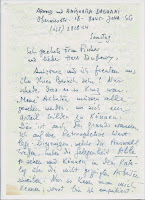



Arnold Daghani shines a light on his artistic self-conception as well as on his relationship to the Romanian post WW2 artist community, such as to the Czernowitzer poet Alfred Kittner, the Romanian art reviewer Eugen Schileru, the Armenian businessman and art collector Krikor H. Zambaccian, the diplomat and art critic Oscar Walter Cisek, who authored short stories, novels, poems and essays in both German and Romanian. In addition we discover at the bottom of these letters a catalogue of Daghani’s works, which apparently were still in his possession before finally emigrating to England and settling in Hove, near Brighton, one year later in 1977. Daghani died in 1985, a deeply frustrated man, and his work is now held at Centre for German-Jewish Studies at the University of Sussex.
Dr Deborah Schultz comes straight to the point stating in her article “Pictorial Narrative, History and Memory in the Work of Arnold Daghani” as follows: “His frustrations were intensified by the lack of public interest in the camps in Ukraine, with all the attention focused on better-known camps such as Auschwitz, and he strongly believed that his account had to be heard. For Daghani writing and image making may have been the means of locating himself and of finding his way.” You will better comprehend this by reading the first paragraph of Daghani’s second letter: “As an ‘homage’, I received from the public prosecutors the entire investigation procedure file, since, according to the chief prosecutor [Fritz Bauer], it’s solely due to me, that they gained knowledge of the atrocities committed on the other side of the Bug River.” But it’s finally G. H. Bennett, Associate Professor in History at the University of Plymouth, who – by his article “The Limits of West German Justice in the 1960s: The Post-War Investigation of Walter Gieseke” and his book “The Nazi, the Painter and the Forgotten Story of the SS Road” – is enlightening the historical dimension for us.
Well, the “Nazi” was Walter Gieseke, Oberstleutnant of the Gendarmerie and SS, the “Painter” was Arnold Daghani and the DG IV (Durchgangsstraße IV) was the “SS Road”, the road building project across the Ukraine which resulted in the murder of substantial numbers of Jewish forced labourers, among those many from Bukovina.
At my previous posting “The Stone Quarry on the Bug River at 8 Miles from N 48°40′ E 29°15′” you’ll find additional reports on the fate of the Jewish forced labourers including excerpts from Andrej Angrick’s article “Forced Labor along the ‘Straße der SS'” and Gerhard (Bobby) Schreiber’s memoirs “A Tale of Survival”. After getting numerous answers to our initial question, the final question concerns the moral condemnation and criminal conviction of the war criminals, but read by yourself G. H. Bennett’s conclusion:
“Gieseke was never brought to trial and Daghani would eventually conclude that the West German investigations into the crimes committed along DGIV were ‘merely a farce, a meaningless gesture’. […] The investigation of Walter Gieseke highlights the problems in the 1950s and 1960s of securing justice for crimes committed during the war. The processes of investigating and prosecuting of German war criminals in the context of West German justice in the 1950s and 1960s were not likely to result in a conviction. Gieseke’s defensive strategies maximized the problems facing investigators which resulted from the set of legal, political, social and investigative contexts that made a trial difficult and, in the eyes of many West Germans, unwanted and unwarranted. […] In the case of Walter Gieseke can be glimpsed many of thecomplexiti es that protected the guilty men and women of post-war Germany. Moreover, study of this case hopefully demonstrates the need to discount concerns about ‘practitioners’ trespassing onto the territory of historians. In studying post-war German justice, and indeed most aspects of legal history, there is ample scope for practitioners and historians to pool their skills and approaches to the mutual benefit of truly interdisciplinary scholarship.There is much to be learned from each other and little to be feared.
Additional Links:
“SS film links officer with war crimes” by BBC
“Lost film unearthed in Devon church…” by Daily Mail
“Arnold Daghani. Who is he?” by Miha Ahronovitz
“The Art of Arnold Daghani” by The Art of Polemics
Welcome to Synagogues 360
Austrian Decoration for Science and Art for Margit Bartfeld-Feller
Margit Bartfeld-Feller und das Ehrenkreuz für Wissenschaft und Kunst der Bundesrepublik Österreich
Berlin – Wien ist ein Katzensprung, von Czernowitz nach Vasjugan in Sibirien sind es bereits weit über viertausend Kilometer und von Tomsk nach Tel Aviv gar mehr als fünftausend, eine lange und große Reise. Die lange große Reise war für Margit Bartfeld-Feller und ihre Familie 1990 die erste Reise in ein westliches demokratisches Land, ein freies Land, das Land Israel, das Gelobte Land, nach 50 Jahren Verbannung. Als Einwanderer wurden sie aufgenommen.
1941 wurde Margit Bartfeld-Feller mit den Eltern und dem Bruder Otti bei Nacht und Nebel aus Czernowitz von den Sowjets nach Sibirien in die Taiga deportiert. Stalin, der Tyrann, befahl diese Untaten. Juden, Intellektuelle, Fabrikanten und politisch Andersdenkende wurden vom Estland bis ans Schwarze Meer in Viehwaggons gepfercht, nordöstlich in Richtung Sowjetunion transportiert und weiter auf Schiffen nach Sibirien zum Schwerstarbeiten verschleppt. „Verrecken“ sollten sie, war Stalins Befehl! Margit war jung, gerade 18 Jahre alt, ihr Bruder jünger. In Czernowitz in der Bukowina wurde Margit Bartfeld 1923 geboren, ging dort zur Schule, für Literatur und Musik begeisterten sie die Eltern. In Czernowitz, der Stadt Rose Ausländers und Paul Celans, lebte Margit in Geborgenheit. Noch bevor Hitlers Schergen in die Bukowina kamen, ließ Stalin die erwähnten Bewohner abholen und schickte sie zum Sterben durch Hunger und unmenschliche Lebensverhältnisse in die Taiga an den Vasjugan. Ein schreckliches Leben erwartete die Deportierten dort. Wie Fliegen starben sie. 1948 heiratete Margit Bartfeld den ebenfalls aus Czernowitz deportierten Kurt Feller. In Krassnojarka, dem „Todesnest“, wie sie den Ort nannten, trafen sie sich wieder. Ihre Ehe begann mit geliehenen Eheringen.
Die Tochter Anita wurde 1954 geboren, die kleine Familie Bartfeld-Feller teilte sich ein Zimmer in Tomsk. 1979 starb Kurt Feller, der inzwischen in Tomsk ein bekannter Architekt und Baumeister geworden war.
Margit Bartfeld Feller schreibt sich seit ihrer Ankunft im Heiligen Land ihre Vergangenheit, ihr Erlebtes, von der Seele. Über zehn Bücher erschienen unter der Herausgabe von Professor Dr. Erhard Roy Wiehn im Hartung & Gorre Verlag in Konstanz.
Der Theodor Kramer Literaturpreis wurde der Schriftstellerin im September 2013 in Österreich verliehen.
Vorletzte Woche überreichte Seine Exzellenz, der Botschafter der Republik Österreich, Herr Dr. Franz Kuglitsch, der einundneunzigjährigen Zeitzeugin und Autorin Margit Bartfeld-Feller in Tel Aviv das Ehrenkreuz für Wissenschaft und Kunst der Republik Österreich.
Christel Wollmann-Fiedler, Berlin, September 2014
Lu Rudel: Memoirs of an Agent for Change in International Development; My Flight Path into the 21st Century.
I am happy to report to you that the book, over which I have been laboring for the past three years, has finally come off the press. The title is, “Memoirs of an Agent for Change in International Development; My Flight Path into the 21st Century.”
The book has been selected for inclusion in the “Memoirs and Occasional Papers” series by The Association for Diplomatic Studies and Training. You can find it on their website, (www.ADST.org). Here is the link:
The printed version is listed for purchase on Amazon as well. Additionally, it is available for downloading at Amazon as an e-book for the Kindle – at the modest price of $3.08.
This short description of the book’s contents appears on the back of the book cover: “Lu Rudel describes his unique experiences with US foreign economic aid programs during some of the most dramatic international events since World War II. These include Iran after the fall of Mosaddegh (1956-1960); Turkey after the military coup of 1960 to the start of the Cuba Missile crisis; India after the death of Nehru (1965-1970); and Pakistan following the Soviet withdrawal from Afghanistan in 1988. Rudel’s firsthand observations on Iran differ markedly from the description of events commonly espoused by some historians and journalists.”He also provides a firsthand account of the political metamorphosis over the past half-century of the “Group of 77” nations as they attempted to employ the UN’s economic development agencies to press for a “New International Economic Order.” These experiences lead him to draw important lessons about the conduct and effectiveness of foreign aid.”After retirement in 1980 he launched a second career, applying lessons learned from his work in international development to creation of a thousand-acre land development and resort in rural Appalachia. His experiences over the following thirty years as an entrepreneur track the relentless growth of government regulations and the disappearance of community support institutions such as local banks, now being replaced by mega-banks.”Finally, he examines global trends of the past eighty years in four critical areas of change affecting our lives – population growth, science and technology, economic systems, and political structures – to draw some surprising conclusions and projections.”
I have placed a selection of photos on the web to complement the chapters of the book. The photos can be accessed by a link on the web site. (www.rudel.net).
I enjoyed writing these stories dealing with my two careers. You will have to decide if they make good reading. A second, companion volume dealing with the more personal aspects of our family life is approaching completion. I’ll let you know when that volume becomes available.
Lu Rudel, Bethesda, MD, October 2014




